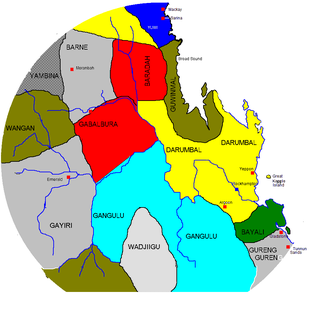Mythology
The origin story of the Minyungal concerns the legend of three brothers, each of whom established one of the tribes of the area. It tells of the arrival to this part of the eastern Australian coastline by 3 men/mythical culture heroes (Berruġ, Mommóm and Yaburóng)and their wives and children in a canoe.
Long ago, Berruġ together with Mommóm (and) Yabúrong came to this land. They came with their wives and children in a great canoe, from an island across the sea. As they came near the shore, a woman on the land made a song that raised a storm which broke the canoe in pieces, but all the occupants, after battling with the waves, managed to swim ashore. This is how 'the men' the paiġål black race, came to this land.The pieces of the canoe are to be seen to this day. If any one will throw a stone and strike a piece of the canoe, a storm will arise, and the voices of Berrúġ and his boys will be heard calling to one another, amidst the roaring elements. The pieces of the canoe are certain rocks in the sea.
At Ballina, Berrúg looked around and said, nyuġ? and all the paiġål about there say nyuġ to the present day. On the Tweed he said, ġando? (ngahndu)and the Tweed paigål say ġando to the present day. This is how the blacks came to have different dialects. Berrúġ and his brothers came back to the Brunswick River, where he made a fire, and showed the paiġål how to make fire. He taught them their laws about the kippåra, and about marriage and food. After a time, a quarrel arose, and the brothers fought and separated, Mommóm going south, Yaburóng west, and Berrúġ keeping along the coast. This is how the paiġål were separated into tribes.

The history of the Gold Coast in Queensland, Australia began in prehistoric times with archaeological evidence revealing occupation of the district by Australian Aborigines for at least 23,000 years. The first early European colonizers began arriving in the late 1700s, settlement soon followed throughout the 19th century, and by 1959 the town was proclaimed a city. Today, the Gold Coast is one of the fastest-growing cities in Australia.
The Badjiri people, also written Budjari or Badyidi, are an Australian Aboriginal people of just north of the Paroo River, close to the southern border of Queensland.
The Tulua people were an Aboriginal Australian people of Queensland, in the southern to central region from the coast to the ranges. The Dappil and Tulua people possibly spoke the same language.
The Gia people, also known as Giya, Kia, Bumbarra, and variants, are an Aboriginal Australian people of the state of Queensland. Little is known of them.
The Wotjobaluk are an Aboriginal Australian people of the state of Victoria. They are closely related to the Wergaia people.
The Kuungkari are an indigenous Australian people of Queensland. They are to be distinguished from the Kunggari.

The Wadjiga people, also known as Wadja, Maudalgo, Wadjainggo, and other variants, were an Aboriginal Australian people of inland eastern Queensland.
The Wakabunga are an indigenous Australian people of the state of Queensland.
The Bidjara people, also spelt Bitjara or Bithara, are an Aboriginal Australian people of south-western Queensland. They spoke a dialect of the Ngura language. They are not to be confused with the Warrego River Pitjara or the Badjiri of the Paroo River, both of whose traditional lands are further to the east of the state.
The Ganulu, also spelt Kanolu, were an Aboriginal Australian people of the state of Queensland.
The Yilba, also written Ilba and Jilba, are or were an Aboriginal Australian people of the present-day state of Queensland.
The Yagalingu were an indigenous Australian people of the state of Queensland. Their language may have been a dialect of Bidjara.

The Yambina were an Aboriginal Australian people of the state of Queensland, whose traditional lands lie inland (westwards) some distance from Mackay.
The Bindal are an indigenous Australian people of the state of Queensland.
The Djankun are an Aboriginal Australian people of Far North Queensland.
The Garaynbal, also written Karingbal, are an Aboriginal Australian people of the state of Queensland. They spoke a dialect of Biri called Garaynbal, now extinct.
The Arakwal are an Aboriginal Australian people of the state of New South Wales.
The Gawambaraay (Kawambarai) are an Aboriginal Australian people of the state of New South Wales, closely connected to the Gamilaraay (Kamilaroi) people. Their traditional lands are in the central–western district of New South Wales
The Wanjiwalku were an indigenous Australian people of the state of New South Wales.
The Wiyabal are an indigenous Australian people of the state of New South Wales.
This page is based on this
Wikipedia article Text is available under the
CC BY-SA 4.0 license; additional terms may apply.
Images, videos and audio are available under their respective licenses.

